SPACECRAFT ATTITUDE DETERMINA TlON AND CONTROL
�
ASTROPHYSICS AND
SPACE SCIENCE LIBRARY
VOLUME 73
�
SPACECRAFT
ATTITUDE DETERMINATION
AND
CONTROL
Edited by
JAMES R. WERTZ
Microcosm, Inc., Torrance ,CA
Written by
Members of the Technical Staff
Attitude Systems Operation
Computer Sciences Corporation
Preparation of this material was supported by the Attitude Determination and Control Section,
Goddard Space Flight Center, National Aeronautics and Space Administration under Contract No.
NAS 5-11999 and by the System Sciences Division, Computer Sciences Corporation.
KLUWER ACADEMIC PUBLISHERS
DORDRECHT f BOSTON f LONDON
�
library of Congress Cataloging in Publication Data
Computer Science Corporation. Attitude Systems Operation.
Spacecraft attitude determination and control.
(Astrophysics and space science library ; v. 73)
'Contract no. NAS 5-11999.'
Bibliography: p.
Includes index.
1. Space vehicles-Attitude control systems. 2. Space vehicles-Guidance
I. Wertz, James R.
systems.
TL3260.C65 1978
ISBN-13: 978-90-277-1204-2
DOl: 10.1007/978-94-009-9907-7
629.47'42
78-23657
II. Title.
III. Series.
e-ISBN-13: 978-94-009-9907-7
Published by D. Reidel Publishing Company,
P. O. Box 17, Dordrecht, Holland.
Sold and distributed in the U.S.A., Canada and Mexico
by D. Reidel Publishir,g Company, Inc.
Lincoln Building, 160 Old Derby Street, Hingham,
Mass. 02043, U.S.A.
Preparation of this material was supported by the Attitude Determination and Control Section,
Goddard Space Flight Center, National Aeronautics and Space Administration under Contract No.
NAS 5-11999 and by the System Sciences Division, Computer Sciences Corporation.
(Reprinted 1980, 1984, 1985, 1986, 1988, 1991, 1994, 1995, 2000, 2002)
All Rights Reserved
Copyright © 1978 by D. Reidel Publishing Company, Dordrecht, Holland
No part of the material protected by this copyright notice may be reproduced or
utilized in any form or by any means, electronic or mechanical
including photocopying, recording or by any informational storage and
retrieval system, without written permission from the copyright owner
�
LIST OF CONTRIBUTING AUTHORS
All the authors are members of the technical staff in the Attitude Systems
Operation, System Sciences Division, Computer Sciences Corporation. Sections
written by each author are in brackets.
John Aiello-B.S. (Astronomy), Villanova University [5.2, Appendix G]
Jawaid Bashir-Ph.D. (Aerospace Engineering), M.S. (Electrical Engineering), Uni
versity of Colorado; B.S. (Electrical Engineering), Karachi University, Pak
istan [I8.I]
Robert M. Beard-M.S. (Mathematics), B.S. (Physics), Auburn University [16.3]
Bruce T. Blaylock-M.S. (Chemistry), University of Virginia; 8.S. (Chemistry),
Eastern Montana College [6.3]
Lily C. Chen-'-Ph.D. (Physics), University of Wisconsin, Madison; M.S. (Physics),
University of Cincinnati; B.S. (Physics), National Taiwan University [7.1, 11.3,
11.4, 11.5, Chapter 10]
Roger M. Davis-M.S. (Mechanical Engineering), Northeastern University; B.S.
(Mechanical Engineering), University of Connecticut [16.4]
Demosthenes Dialetis-Ph.D. (Physics), University of Rochester; B.Sc. (Physics),
University of Athens, Greece [16.4]
Lawrence Fallon, III-Ph.D., M.S. (Materials Science), University of Virginia; B.S.
(Engineering Physics), Loyola College [6.4, 6.5, 7.6, 7.8, 13.4, 13.5, 21.3,
Appendix D]
B. L. Gambhir-Ph.D. (Physics), University of Maryland; M.Sc. (Physics), B.Sc.
(Physics, Mathematics, English), Punjab University, India [6 . .1, 19.1]
David M. Gottlieb-Ph.D. (Astronomy), University of Maryland; B.A. (Mathema
tics), Johns Hopkins University [5.3, 5.6, 7.7]
Mihaly G. Grell-M.S. (Physics), University of Sciences, Budapest [19.2]
Dale Headrick-Ph.D., M.S. (Physics), Yale University; B.S. (Physics) Louisiana
State University [6.6, 18.2, 19.4]
Steven G. Hotovy-Ph.D. (Mathematics), University of Colorado; B.S. (Mathema
tics), University of Notre Dame [7.2, 13.2, 13.3]
James S. Legg, Jr.-M.S. (Physics), University of North Carolina; A.B. (Physics,
Mathematics), Washington and Lee University [8.1,8.3,8.4,9.1]
Gerald M. Lemer-Ph.D. (Physics), University of Maryland; B.A. (Physics), Johns
Hopkins University [6.1, 6.2, 6.9, 7.1, 7.5, 9.2, 9.3, 12.2, 12.3, 18.1, 18.3, 19.5,
Appendix F]
Menachem Levitas-Ph.D. (Physics), University of Virginia; B.S. (Physics), Uni
versity of Portland [7.3, 17.3]
K. Liu-B.S. (Physics), National Taiwan University [4.3]
�
vi
LIST OF CONTRIBUTING AUTHORS
F. L. Markley-Ph.D. (Physics), University of California, Berkeley; B.E.P. (Engi
neering Physics), Cornell University [7.4, 7.9: 12.1, 15.2, 16.1, 16.2, 17.1,
Appendix C]
Prafulla K. Misra-Ph.D., M.S. (Electrical Engineering), University of Maryland;
B.Tech. (Electrical Engineering), Indian Institute of Technology, India [6.9]
Janet Niblack-M.A. (Mathematics), University of Texas; B.A. (Mathematics),
Florida State University [S.2]
Michael Plett-Ph.D. (Physics), University of Virginia; B.S. (Physics), University of
Cincinnati [5.1, 16.3, Appendix H]
Paul V. Rigterink-Ph.D. (Astronomy), University of Pennsylvania; B.A.
(Mathematics), Carleton College [13.4]
John N. Rowe-Ph.D., M.S. (Electrical Engineering), Pennsylvania State Univer
sity; M.A. (Physics), Western Michigan University; B.A. (Physics), Oakland
University, Michigan [4.4, 5.4, 5.5]
Ashok K. Saxena-M.S. (Aerospace Engineering), Virginia Polytechnic Institute
and State University; B.E. (Mechanical Engineering), Jadavpur Univer
sity, India [1S.4, Appendix I]
Myron A. Shear-M.S. (Physics), University of Illinois; B.A. (Physics, Chemistry),
Harvard University [20.1, 20.3, 21.1]
Malcolm D. Shuster-Ph.D. (Physics), University of Maryland; S.B. (Physics),
Massachusetts Institute of Technology [19.2]
Peter M. Smith-Ph.D. (Chemistry), Georgetown University; M.Sc. (Spectroscopy),
B.Sc. (Chemistry), Manchester University, England [11.1, 11.2, 21.4]
Des R. Sood-D. Eng. Sc. (Mechanical Engineering), Columbia University; M.S.
(Mechanical Engineering), Roorkee University, India; B.S. (Mechanical En
gineering), Delhi University, India [6.7, 19.1]
C. B. Spence, Jr.-Ph.D., M.S. (Physics), College of William and Mary; B.S.
(Physics), University of Richmond [17.1, 17.2]
Conrad R. Sturch-Ph.D. (Astronomy), University of California, Berkeley; M.S.,
B.A. (Physics), Miami University, Ohio [Appendix J]
Gyanendra K. Tandon-Ph.D. (Physics), Yale University; M.Sc. (Electronics), B.Sc.
(Physics, Mathematics), Allahabad University, India [17.4, 21.2, Appendix E]
Vincent H. Tate-M.S., B.S. (Aerospace Engineering), Pennsylvania State Univer
sity [15.3]
James R. Wertz-Ph.D. (Physics), University of Texas, Austin; S.B. (Physics),
Massachusetts InstituteofTechnology[4.1,4.2,9.4, 11.3, 11.4, 11.5, 13.1, 15.1;
Chapters 1,2, 3, 10, 14, 22; Appendices A, B, K, L, M]
Robert S. Williams-Ph.D. (Physics), University of Maryland; B.S. (Physics),
California Institute of Technology [6.S, 7.10, 19.3]
Kay yong-Ph.D., M.S. (Mechanical Engineering), Rensselaer Polytechnic Insti
tute; B.S. (Mechanical Engineering), National Cheng-Kung University, Tai
wan. [5.2]
�
FOREWORD
Roger D. Werking
Head, Attitude Determination and Control Section
National Aeronautics and Space Administration/
Goddard Space Flight Center
Extensiye work has been done for many years in the areas of attitude
determination, attitude prediction, and attitude control. During this time, it has
been difficult to obtain reference material that provided a comprehensive overview
of attitude support activities. This lack of reference material has made it difficult
for those not intimately involved in attitude functions to become acquainted with
the ideas and activities which are essential to understanding the various aspects of
spacecraft attitude support. As a result, I felt the need for a document which could
be used by a variety of persons to obtain an understanding of the work which has
been done in support of spacecraft attitude objectives. It is believed that this book,
prepared by the Computer Sciences Corporation under the able direction of Dr.
James Wertz, provides this type of reference.
This book can serve as a reference for individuals involved in mission planning,
attitude determination, and attitude dynamics; an introductory textbook for stu
dents and professionals starting in this field; an information source for experimen
ters or others involved in spacecraft-related work who need information on
spacecraft orientation and how it is determined, but who have neither the time nor
the resources to pursue the varied literature on this subject; and a tool for
encouraging those who could expand this discipline to do so, because much
remains to be done to satisfy future needs.
The primary purpose of this book is to provide short descriptions of various
aspects of attitude determination, prediction, and control with emphasis on the
ground support which presently must be provided. The initial chapters provide the
necessary background and describe environment models and spacecraft attitude
hardware. The authors then present the fundamentals that are essential to a basic
understanding of the activities in this area as well as flight-proven concepts which
can be used as a basis for operational state-of-the-art activities or as a stepping
stone to improved processes. In a limited fashion, Chapter 22 presents future
activities which affect or are a part of spacecraft attitude support. It is not the
intention of this book to advance the state of the art but rather to call attention to
the work that has been done in the successful support of spacecraft attitude
requirements and to stimulate future thinking.
�
PREFACE
The purpose of this book is to summarize the ideas, data, and analytic
techniques needed for spacecraft attitude determination and control in a form that
is readable to someone with little or no previous background in this specific area. It
has been prepared for those who have a physics or engineering background and
therefore are familiar with the elementary aspects of Newtonian mechanics, vector
algebra, and calculus. Summaries of pertinent facts in other are~s are presented
without proof.
This material has been prepared by 35 members of the technical staff of the
Attitude Systems Operation of the System Sciences Division of Computer Sciences
Corporation (CSC) for the Attitude Determination and Control Section of NASA's
Goddard Space Flight Center. It necessarily reflects our experience in this area and
therefore is concerned primarily with unmanned, Earth-orbiting spacecraft. None
theless, the basic principles are sufficiently broad to be applicable to nearly any
spacecraft.
Chapters l, 2, 3, 10, and 15 provide introductory material at a more qualitative
level than that of the other chapters. The suggested order of reading depends on
the background and interest of the reader:
I. Those who are primarily concerned with mission planning and analysis and
who would like a general overview should read Chapters I, 2, 3, 10, 15, and 22.
2. Those who are primarly interested in attitude determination should read
Chapters I and 2, Sections 3.1 through 3.3, Chapter 10, Appendices A and B, and
Chapters II through 14.
3. Those who are primarily interested in attitude dynamics and control should
read Chapters I and 2, Sections 3.1 through 3.3 and 12.1, Chapters 15 through 19,
and Appendices C through H.
4. Those who are primarily interested in the space environment, attitude
hardware, and data acquisition should read Chapters I through 9 and Appendices
G through J.
5. Those who are primarily interested in the development of mission related
software should read Chapters I and 2, Sections 3.1 through 3.3, Chapters 20 and
21, Chapters 8 and 9, Sections Il.l and 11.2, and Chapters 12, 4, 5, and 7.
The International System of Units is used throughout the book and a detailed
list of conversion factors is given in Appendix K. Because nearly all numerical
work is now done with computers or hand calculators, all constants are given to
essentially their full available accuracy. Acronyms have generally been avoided,
except for spacecraft names. The full spacecraft names are listed in Appendix I,
which also provides a cross-referenced list of the attitude hardware used on various
spacecraft, including all those used as examples throughout the text.
_ Because much of the material presented here has not appeared in the open
literature, maJlY of the references are to corporate or government documents of
limited Circulation.- To -improve the exchange of information, Computer Sciences
�
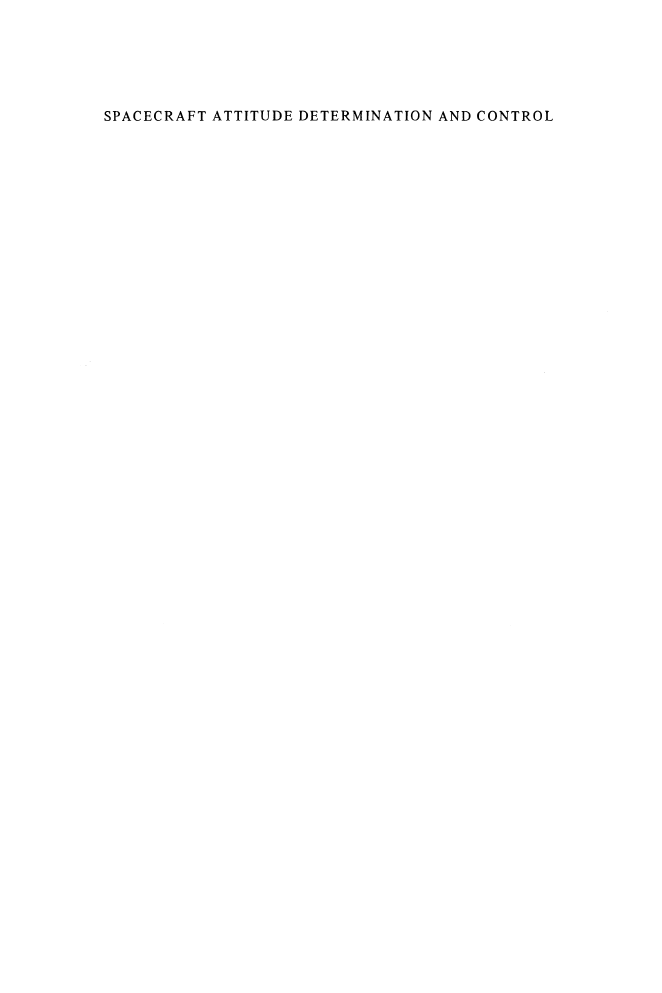
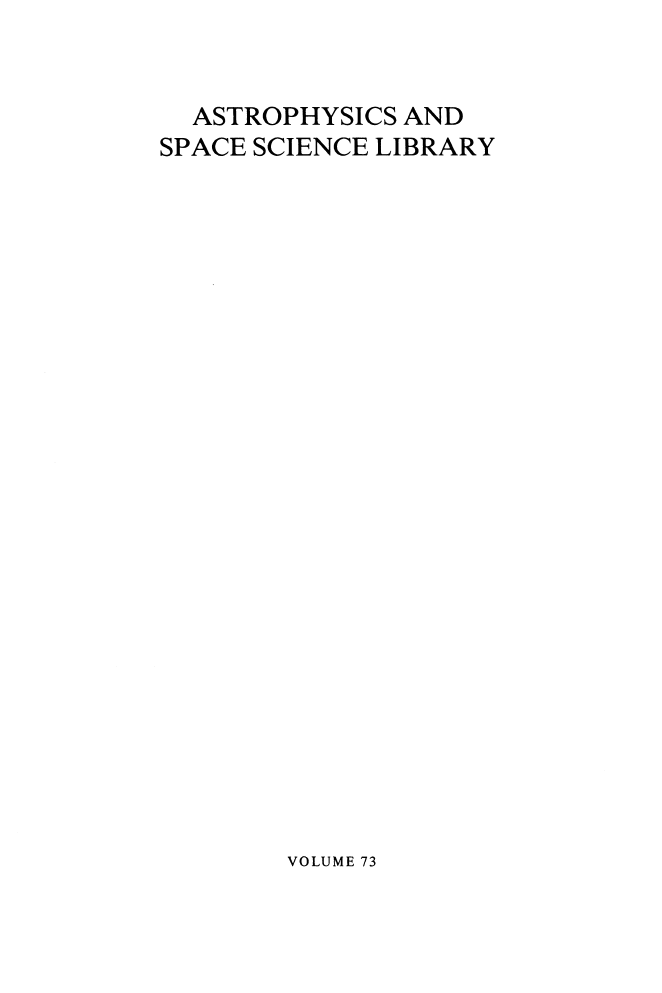
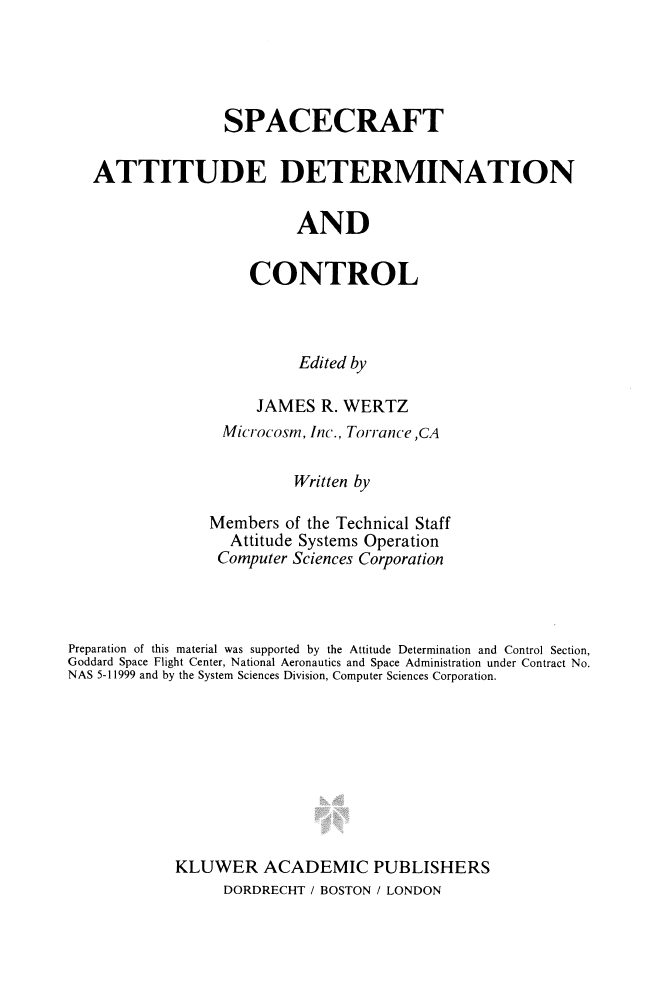
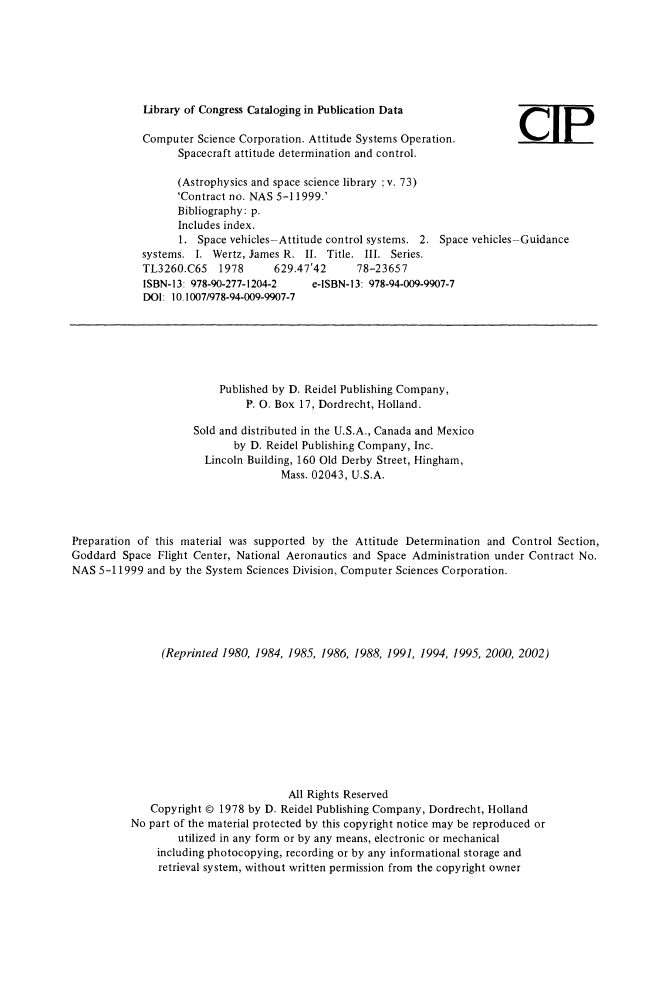
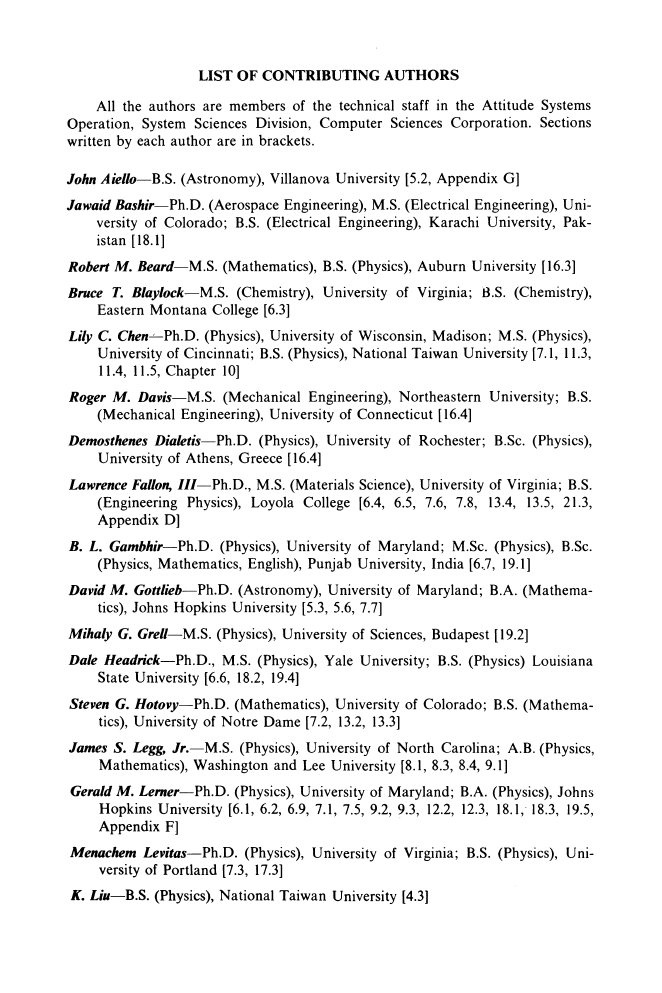

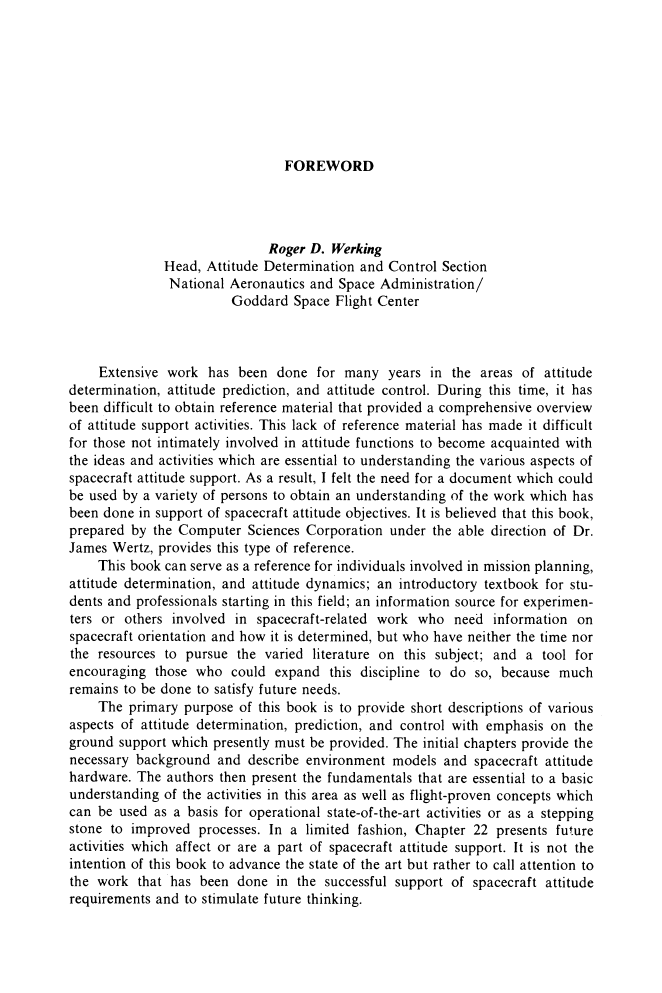
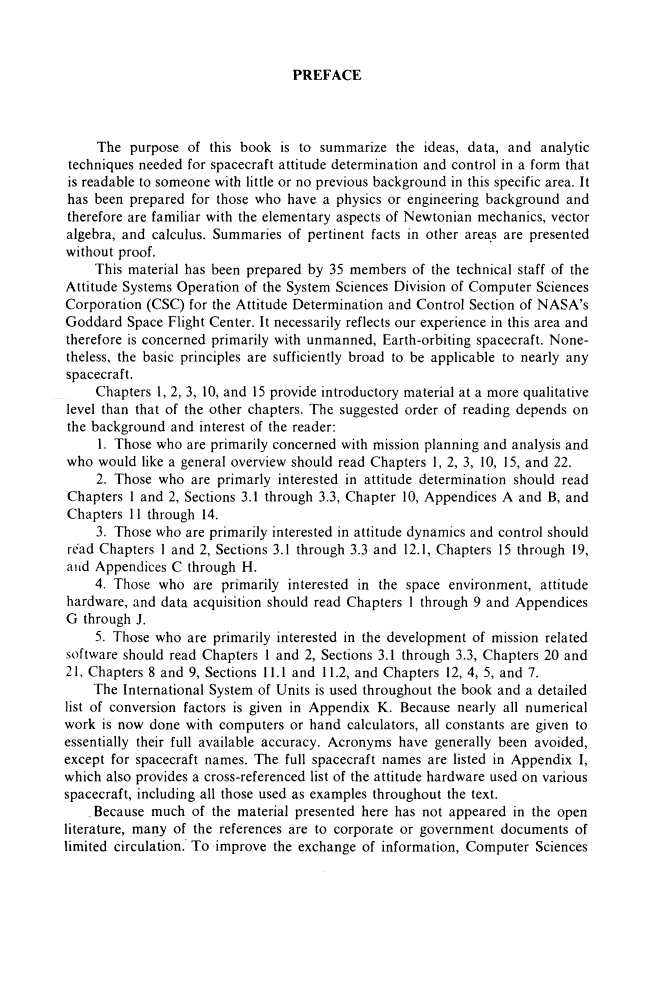








 2023年江西萍乡中考道德与法治真题及答案.doc
2023年江西萍乡中考道德与法治真题及答案.doc 2012年重庆南川中考生物真题及答案.doc
2012年重庆南川中考生物真题及答案.doc 2013年江西师范大学地理学综合及文艺理论基础考研真题.doc
2013年江西师范大学地理学综合及文艺理论基础考研真题.doc 2020年四川甘孜小升初语文真题及答案I卷.doc
2020年四川甘孜小升初语文真题及答案I卷.doc 2020年注册岩土工程师专业基础考试真题及答案.doc
2020年注册岩土工程师专业基础考试真题及答案.doc 2023-2024学年福建省厦门市九年级上学期数学月考试题及答案.doc
2023-2024学年福建省厦门市九年级上学期数学月考试题及答案.doc 2021-2022学年辽宁省沈阳市大东区九年级上学期语文期末试题及答案.doc
2021-2022学年辽宁省沈阳市大东区九年级上学期语文期末试题及答案.doc 2022-2023学年北京东城区初三第一学期物理期末试卷及答案.doc
2022-2023学年北京东城区初三第一学期物理期末试卷及答案.doc 2018上半年江西教师资格初中地理学科知识与教学能力真题及答案.doc
2018上半年江西教师资格初中地理学科知识与教学能力真题及答案.doc 2012年河北国家公务员申论考试真题及答案-省级.doc
2012年河北国家公务员申论考试真题及答案-省级.doc 2020-2021学年江苏省扬州市江都区邵樊片九年级上学期数学第一次质量检测试题及答案.doc
2020-2021学年江苏省扬州市江都区邵樊片九年级上学期数学第一次质量检测试题及答案.doc 2022下半年黑龙江教师资格证中学综合素质真题及答案.doc
2022下半年黑龙江教师资格证中学综合素质真题及答案.doc